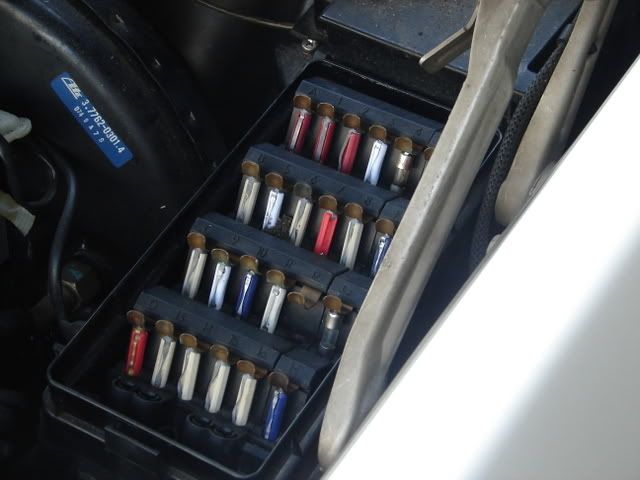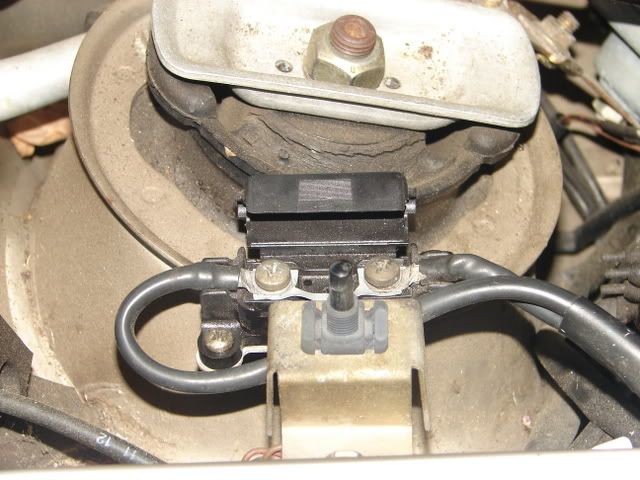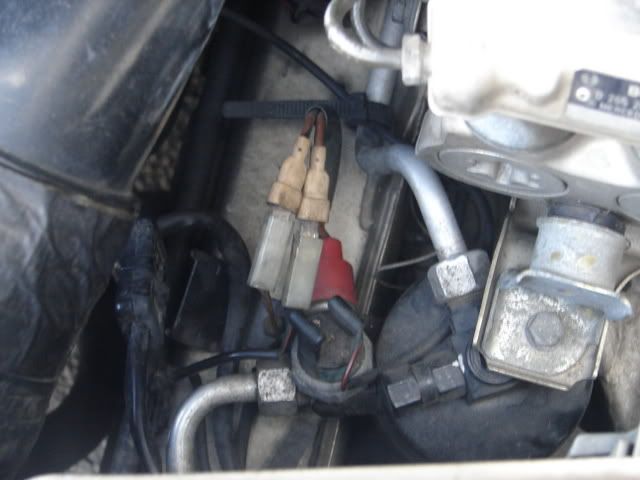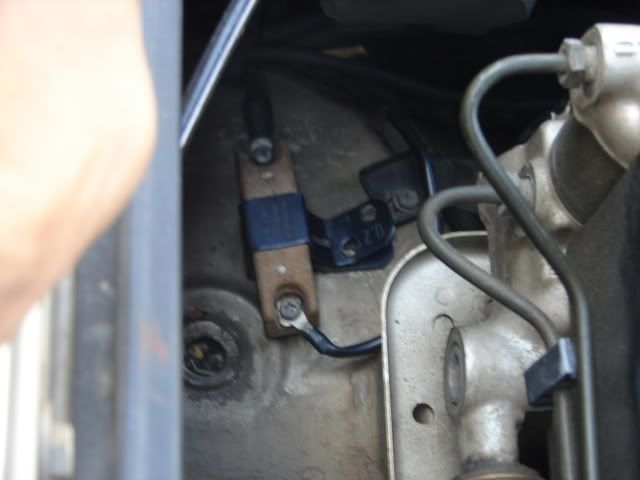Another Aux Fan
#1
Senior Member
Thread Starter
Join Date: May 2004
Location: Atlanta
Posts: 261
Likes: 0
Received 1 Like
on
1 Post
1983 240D, 1989 300E
Another Aux Fan
1989 300E
OK so I am trouble shooting my aux fan as it doesn't work. I have search through many other threads but have not seen one with pictures. Different people have been using different names for the same part which has lead to some confusion.
First I have put 12 volts directly to the fan plug and the fan spins.

I checked with volt meter that 12v is running across the fuse in the fuse D. Which is the fuse for the aux fan.

I checked with volt meter that 12v is running across the strip fuse.

I jumped the AC dry receiver together. I get a clicking noise from the relays behind the fuse box.

I jumped the temp switch and I get a clicking sound from the relay behind the fuse box.

I tested the resistor and got no voltage. I tried jumping the wires and still got not voltage.

I am not sure what else to check. I prefer not to trace every single wire in the whole system. Thanks for your help in advance.
OK so I am trouble shooting my aux fan as it doesn't work. I have search through many other threads but have not seen one with pictures. Different people have been using different names for the same part which has lead to some confusion.
First I have put 12 volts directly to the fan plug and the fan spins.

I checked with volt meter that 12v is running across the fuse in the fuse D. Which is the fuse for the aux fan.

I checked with volt meter that 12v is running across the strip fuse.

I jumped the AC dry receiver together. I get a clicking noise from the relays behind the fuse box.

I jumped the temp switch and I get a clicking sound from the relay behind the fuse box.

I tested the resistor and got no voltage. I tried jumping the wires and still got not voltage.

I am not sure what else to check. I prefer not to trace every single wire in the whole system. Thanks for your help in advance.
Last edited by LoveLEE143; 05-29-2007 at 12:23 PM.
#2
MBWorld Fanatic!
Join Date: Jul 2005
Location: Boston
Posts: 3,094
Likes: 0
Received 0 Likes
on
0 Posts
is a German Tank
1989 300E
OK so I am trouble shooting my aux fan as it doesn't work. I have search through many other threads but have not seen one with pictures. Different people have been using different names for the same part which has lead to some confusion.
First I have put 12 volts directly to the fan plug and the fan spins.
I am not sure what else to check. I prefer not to trace every single wire in the whole system. Thanks for your help in advance.
OK so I am trouble shooting my aux fan as it doesn't work. I have search through many other threads but have not seen one with pictures. Different people have been using different names for the same part which has lead to some confusion.
First I have put 12 volts directly to the fan plug and the fan spins.
I am not sure what else to check. I prefer not to trace every single wire in the whole system. Thanks for your help in advance.
stupid question but -
EDIT: NEVERMIND I don't know how I failed to understand it's your "fan" not working itself...

Last edited by shadowgriffen; 05-29-2007 at 12:43 PM.
#4
MBWorld Fanatic!
Join Date: Jul 2005
Location: Boston
Posts: 3,094
Likes: 0
Received 0 Likes
on
0 Posts
is a German Tank
#5
MBWorld Fanatic!
Join Date: Dec 2006
Location: St. Croix, US Virgin Islands
Posts: 1,033
Likes: 0
Received 0 Likes
on
0 Posts
1995 E320 SE, 162,000 Miles (Sold)
12 volts DC ACROSS fuse = blown fuse. Should be 0 volts DC across fuse, 12VDC from both sides of fuse to ground.
I've read on here that many people replace all of their fuses to eliminate problems like this. I see there a few fuses that look like they are from a Dodge Dart in there. At least wiggle all of them around to get a good connection.
I've read on here that many people replace all of their fuses to eliminate problems like this. I see there a few fuses that look like they are from a Dodge Dart in there. At least wiggle all of them around to get a good connection.
Last edited by shdoug; 05-29-2007 at 01:35 PM.
#6
Senior Member
Thread Starter
Join Date: May 2004
Location: Atlanta
Posts: 261
Likes: 0
Received 1 Like
on
1 Post
1983 240D, 1989 300E
OK I put wire straight from the battery to the resistor in the last picture. If I put it on the top of the resistor then the fan spins at a low level. If I put it on the bottom side then the fan spins at a high level.
#7
MBWorld Fanatic!
Join Date: Dec 2006
Location: St. Croix, US Virgin Islands
Posts: 1,033
Likes: 0
Received 0 Likes
on
0 Posts
1995 E320 SE, 162,000 Miles (Sold)
It can also be activated by one of the temp sensors at the t-stat housing, but I THINK that is an input to a logic board somewhere. Note my signature/disclaimer.
Trending Topics
#8
Junior Member
Join Date: Apr 2007
Location: Richmond Va
Posts: 39
Likes: 0
Received 0 Likes
on
0 Posts
2002 CLK 320
I am not sure if your problem is like mine. My problem was that the aux fan would not come on under any normal operation conditions and the engine would heat up to near max when I sat in traffic for a while.
What I did was take off the fuse box cover lid that you open to get to the normal fuses. Then, you see two screws directly underneath the lid as well as four more a little further back towards the cabin, all of which hold down the black plastic cover that the fuse lid snaps onto. You will need to open the hood all the way for this. Then, once the screws are out, take the cover off, and you will see a bunch more fuses, all of which control the low and high power fan setting. As soon as I replaced the fuses, one of which was obviously melted through, the fan works perfectly.
I hope this helps,
Leo
What I did was take off the fuse box cover lid that you open to get to the normal fuses. Then, you see two screws directly underneath the lid as well as four more a little further back towards the cabin, all of which hold down the black plastic cover that the fuse lid snaps onto. You will need to open the hood all the way for this. Then, once the screws are out, take the cover off, and you will see a bunch more fuses, all of which control the low and high power fan setting. As soon as I replaced the fuses, one of which was obviously melted through, the fan works perfectly.
I hope this helps,
Leo
#9
Newbie
Join Date: Jun 2007
Location: Johannesburg, South Africa
Posts: 9
Likes: 0
Received 0 Likes
on
0 Posts
2001 CLK320, 2000 SL320 V6
Aux fan not working
Good Day
If both relays are clicking then it could be a problem with the wiring from the relays to the aux fan resistor or the relays themselves are faulty.
The two relays are in a plastic box (remove screws to release lid) behind the fusebox.
The ac HP switch switches on the one relay which in turn conects to the low speed side of the resistor, the coolant switch switches on the other relay which connects to the high speed side of the resistor.
Trust this is of use
If both relays are clicking then it could be a problem with the wiring from the relays to the aux fan resistor or the relays themselves are faulty.
The two relays are in a plastic box (remove screws to release lid) behind the fusebox.
The ac HP switch switches on the one relay which in turn conects to the low speed side of the resistor, the coolant switch switches on the other relay which connects to the high speed side of the resistor.
Trust this is of use
#11
Junior Member
Join Date: Aug 2007
Location: Las Vegas, NV
Posts: 39
Likes: 0
Received 0 Likes
on
0 Posts
1987 260E
Pull the fuse out and check the resistance from the output of the fuse(bottom) and the wire going to the fan, should be less than 0.5ohms. My car had the same issue and the fuse got so hot causing the fusebox to melt under the fuse pushing the terminal down and causing an open circuit. I heated up that portion of the box with butane torch and pushed the terminal back up, let it cool and then packed the fuse connection with dielectric grease to promote a good connection.
#12
Junior Member
Join Date: Nov 2004
Location: Los Angeles
Posts: 16
Likes: 0
Received 0 Likes
on
0 Posts
'98 S500
When checking a fuse in a circuit, black lead goes to a solid ground, the red lead goes first to one side of the fuse, then the other side. If there is power to the fuse, you should see exactly the same voltage reading on each side. If you get zero voltage on both sides, either that circuit isn't powered up (ex. key off) or the power to the fuse block is a problem. Not all fuses have power all the time and under all circumstances. Fuses are also subject to intermittant corrosion and thermal failures - it may take a particular circumstance for a fuse to stop "fusing". The act of removing and reinserting a fuse may be all that is required to reset the failure condition and "fix" the problem.
Measure resistance (Ohms) when checking a fuse out of a circuit or fuseblock/holder. Red lead to one end, black lead to the other with nothing touching the fuse except the meter leads. Should be zero ohms; dead short. Anything other than zero ohms could be a problem.
Hope that helps.









